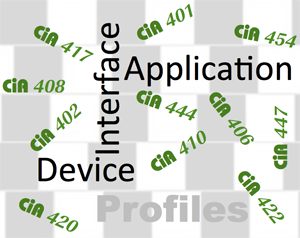CANopen profiles

The set of CANopen specifications comprises different kinds of profiles. All these profiles specify process data (to be mapped into PDOs), configuration parameters (accessed by means of SDOs), and diagnostic information (provided by means of EMCY or readable by means of SDOs). The device type parameter (Index 1000h) indicates the implemented profile.
Generic and application-specific device profiles specify the interface of a logical device as defined in CiA 301. This means they describe the object dictionary entries in the index range from 6000h to 9FFFh. Additionally, they might specify PDO parameters and some other parameters in the index range from 1000h to 1FFFh. Usually, the corresponding PDOs are produced and consumed by the device with the NMT manager functionality, which typically provides the SDO client related to the default SDO server. The most used profiles are CiA 401 for generic I/O modules and CiA 402 for motion controllers and drives.
For devices without application functionality, CANopen interface profiles are specified. They are similar to the device profiles, but they do not specify process inputs and outputs. Instead they describe the functionality of another application-independent network technology. Interface profiles may be regarded as specific device profiles featuring proxy functions. A typical interface profile is specified in CiA 446. It enables a standardized access to AS-interface bus-systems. Gateways connecting CANopen networks to wireless transmission media are specified in the CiA 457 interface profile for wireless transmission media-based CANopen devices.
Application profiles specify all functional interfaces used in a network. It is a system design approach, so to speak. Application profiles are based on the description of a set of virtual device interfaces. A CANopen device may implement one or several virtual devices. Typical application profiles are CiA 417 (also known as CANopen Lift) or CiA 422 (also known as CleANopen). The CiA 447 application profile specifies a CANopen network used in special-purpose vehicles such as taxis, ambulances, and police cars.
In both approaches, the device and the application profile, system designers are able to reconfigure the default behavior in order to tailor the network communication to the system requirements. Devices compliant to the same profile are interoperable and partly or completely exchangeable. They provide a standardized application functionality regarding the implemented process data, configuration parameters, and diagnostic information. Optionally, application finite state automata (FSA) are standardized in order to achieve interoperability with the application controller.